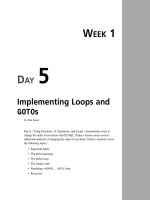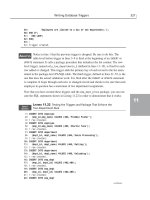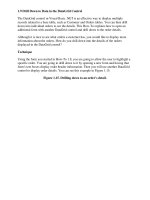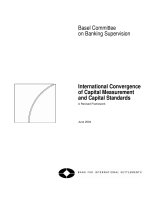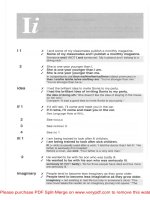Tài liệu Diagnosis & treatment of tuberculosis in HIV co-infected patients pptx
Bạn đang xem bản rút gọn của tài liệu. Xem và tải ngay bản đầy đủ của tài liệu tại đây (1.1 MB, 16 trang )
Introduction
Humanimmunodeciencyvirus(HIV)associated
tuberculosis(TB)remainsamajorglobalpublichealth
challenge. By the end of 2009, an estimated 33.3
millionpeoplewerelivingwithHIV,thevastmajority
in sub-Saharan Africa and Asia. An estimated 2.6
million individuals had become newly infected with
HIV and 1.8 million had died of AIDS in that year
alone
1
.TBisthemostcommonopportunisticinfection
(OI)amongHIV-infectedindividuals,andco-infected
individuals are at high risk of death
2,3
.Theestimates
oftheglobalburdenofdiseasecausedbyTBin2009
Review Article
Diagnosis&treatmentoftuberculosisinHIVco-infectedpatients
C.Padmapriyadarsini,G.Narendran&SoumyaSwaminathan
National Institute for Research in Tuberculosis (Indian Council of Medical Research), Chennai, India
ReceivedOctober31,2011
Human immunodeciency virus (HIV) associated tuberculosis (TB) remains a major global public
health challenge, with an estimated 1.4 million patients worldwide. Co-infection with HIV leads to
challenges in both the diagnosis and treatment of tuberculosis. Further, there has been an increase in
rates of drug resistant tuberculosis, including multi-drug (MDR-TB) and extensively drug resistant
TB (XDRTB), which are difcult to treat and contribute to increased mortality. Because of the poor
performance of sputum smear microscopy in HIV-infected patients, newer diagnostic tests are urgently
required that are not only sensitive and specic but easy to use in remote and resource-constrained
settings. The treatment of co-infected patients requires antituberculosis and antiretroviral drugs to be
administered concomitantly; challenges include pill burden and patient compliance, drug interactions,
overlapping toxic effects, and immune reconstitution inammatory syndrome. Also important questions
about the duration and schedule of anti-TB drug regimens and timing of antiretroviral therapy remain
unanswered. From a programmatic point of view, screening of all HIV-infected persons for TB and vice-
versa requires good co-ordination and communication between the TB and AIDS control programmes.
Linkage of co-infected patients to antiretroviral treatment centres is critical if early mortality is to be
prevented. We present here an overview of existing diagnostic strategies, new tests in the pipeline and
recommendations for treatment of patients with HIV-TB dual infection.
Key words Co-infection-diagnosis-drugresistance-HIV-IRIS-treatment-tuberculosis
wereasfollows:9.4millionincidentcases(range8.9-
9.9 million), 1.3million deaths amongHIV-negative
TB patients (range 1.2-1.5 million) and 0.38 million
deaths among HIV-positiveTB patients (range 0.32-
0.45million).MostTBcaseswereintheSouth-East
Asia, African and Western Pacic regions (35, 30
and 20%, respectively).Anestimated 11-13 per cent
of incident cases were HIV-positive
4
. TB may occur
atanystageofHIVdiseaseandisfrequentlytherst
recognizedpresentationofunderlyingHIVinfection
5,6
.
AscomparedtopeoplewithoutHIV,peoplelivingwith
HIV(PLWH)havea20-foldhigherriskofdeveloping
850
IndianJMedRes134,December2011,pp850-865
TB
7
and the risk continues to increase as CD4 cell
countsprogressivelydecline
5
.
AsaresultofWHO’s3by5campaign,>6million
HIV-infected individuals in resource limited settings
havehadaccesstoantiretroviraltherapy(ART)since
2004
8
,thoughthisisstillfarshortoftheactualneed.
AlthoughART can reduce the incidence of TB both
at the individual and population level, PLWH on
ARTstillhavehigherTBincidenceratesandahigher
risk of dying from TB
9
.Thismay be due to delayed
initiation of ART or the fact that patients present
with advanced TB or both
10
. Routine TB screening
amongPLWHofferstheopportunitytoidentifythose
withoutTB,preventTBbychemoprophylaxisaswell
as todiagnose and promptly treat TB.However, co-
administration of ART along with anti-TB therapy
presents several management challenges, including
drug-druginteractions,overlappingdrugtoxicitiesand
immunereconstitutionsyndrome.
Inthisreview,wesummarizeandupdateinformation
onthescreening,diagnosisandmanagementofTBin
HIVinfectedadults.
Diagnosis of TB in HIV-infected individuals
Clinical screening algorithms:TheWHOrecommends
TBscreeningatthetimethatHIVinfectionisdiagnosed,
before the initiation of antiretroviral therapy and at
regular intervals during follow up
11
. Currently there
is nointernationally accepted evidence-based tool to
screen for TB in PLWH. Multiplestudies have been
conductedtodevelopa simplemethodforrulingout
TBinpeoplewithHIVinfection,butmethodological
issuesprecludetheuseofanyoftheseasthebasisfor
globalhealthpolicy
12-14
.In2007,aWHOInternational
Expert Committee issued new guidelines to improve
thediagnosisofTBinHIVinfectedindividuals
15
.The
feasibility, accuracy and operational performance of
these guidelines were tested in various settings and
were found to be acceptable
16
. It was recommended
thatscreeningforTBshouldincludeaskingquestions
about a combination of symptoms rather than only
aboutchroniccough.Arecentmeta-analysisevaluated
the performance of individual and combinations of
symptoms as screening rules for TB among 8,148
participants from 12 studies
17
. The best performing
rule was the presence of any one of current cough,
fever, night sweats or weight loss. The overall
sensitivityofthisrulewas79percent,increasing to
90percentinclinicalsettingsbutthespecicitywas
only50percent.Thenegativepredictivevalueofthe
rulewashighacrossarangeofTBdiseaseprevalence
estimatesaswellasacrosshighandlowCD4counts.
The major change to existing practice would be the
replacementofchroniccoughwithcurrentcoughasa
screeningquestionandtheadditionofothersymptoms
tostandardscreening
17
.While ascreeningtoolneeds
tohavehighsensitivityandnegativepredictivevalue,
a diagnostic strategy should ideally have both high
sensitivity and specicity. The screening tool could
beusedinARTclinicstoidentifypatientseligiblefor
chemoprophylaxis as well as to identify those who
needfurtherinvestigationsforTB.
Radiographic features:Thespectrumofradiographic
manifestation of pulmonary TB is dependent on the
relative level of HIV-related immunodeciency
18
.
During the early phase ofHIV whenindividuals are
not immunosuppressed, the radiographic pattern is
similar to HIV uninfected individuals with more
typicallesions-upperlobeinltrateswithorwithout
cavities. With advancing immunosuppression, extra
pulmonary involvement, intra-thoracic/mediastinal
lymphadenopathy,lowerlobeinltrateandmiliaryTB
becomemorecommon
19
.
Adding chest X-ray to symptom screening
increasesthenumberofTBcasesdetectedbutisnon-
specicandaddstothecostofscreening.ChestX-ray
can still miss a substantial proportion of individuals
withsub-clinicaldisease,oftenseeninadvancedHIV
immunosuppression
20
. Moreover, chest radiographs
may appear normal in 7-14% of patients with HIV/
TB
18,19
.Thissub-populationofco-infectedindividuals
isparticularlylikelytobenetfromsputumcultureor
nucleicacidamplicationtestsforTBdiagnosis.
Sputum smear microscopy:Themostfrequentmethod
ofTBdetectioninvolvesmicroscopicexaminationof
sputumforacid-fastbacilli(AFB)
21
.Microscopyhas
theadvantageof beinginexpensive,relatively rapid
to perform, andspecicin most settings. However,
to be considered smear positive a specimen needs
to contain approximately 10
5
mycobacteria per
milliliter. The sensitivity of sputum microscopy in
HIV infection rangesfrom 43 to 51 per cent
22
, and
in manyresource-limited settingswith high ratesof
co-infection, the sensitivity may be much lower
23
.
Methods that improve speed or sensitivity include
uorescence microscopy
24
and alternative specimen
processing methods, such as concentration, bleach
sedimentation and same-day sputum collection (so-
calledfrontloading)strategies
25-27
.Anyprocedurefor
PADMAPRIYADARSINIet al:HIV-TBCOINFECTION 851
digestionorliquefactionfollowedbycentrifugation,
prolongedgravitysedimentation,orltrationincreases
sensitivityby13to33percentoverdirectmicroscopy,
whencultureisusedasthereferencestandard
26
.
Equipmentcostslimitthewideruseofuorescence
microscopes in resource-limited settings. Alternative
technologies using light-emitting diode bulbs allow
uorescence microscopes at a much lower cost;
eld-level evaluation showed promising results and
this technology is now being widely scaled up
28,29
.
Nevertheless, because sputum smear is the primary
mode of TB detection in many resource constrained
settings, a sizable number of smear-negative
individuals often remain undiagnosed or receive
delayedanti-TBtherapy
30
.Itisalsoimportanttonote
thatdrugsusceptibilitycannotbeascertainedbysmear
microscopy, so treatment for drug resistant TB is
invariablyempirical.
Growth based detection: Culture of Mycobacterium
tuberculosis is much more sensitive than smear
microscopy and has been recommended to assist in
the diagnosis of TB in HIV-infected individuals
31
.
Culturealsoallowssubsequentstraincharacterization
anddrugsusceptibilitytests.Thetraditionalmethodof
inoculatingsolidmediumsuchastheLowenstein-Jenson
(L-J) medium or Middlebrook medium is sensitive
butslow,asgrowthmaynotbevisibleuntilafter6-8
wkofincubation.Thisresultsindelayininitiationof
therapy,withdetrimentaleffectsonoutcomeofHIV-
TB co-infected patients. Automated liquid culture
systems detect growth of mycobacteria within 1-2
wkbybacterialcarbondioxideproductionoroxygen
consumptionwithradiometricsensors(BACTEC460
TB;BectonDickinsonDiagnosticInstrumentsSystems,
USA), uorescent sensors [BACTEC Mycobacteria
GrowthIndicatorTube(MGIT)960;BectonDickinson
DiagnosticInstrumentsSystems],colorimetricsensors
(MB/BacTsystem;OrganonTeknika),pressuresensors
(ESPculturesystemII;DifcoLaboratories,USA),or
redoxreagents,suchasAlamarblue
32-35
.
Microscopic observation drug susceptibility
(MODS)assayisalowcostnon-commercialmethod
thatcanbeusedfordetectionof microcolonies,cord
formation and for early detection of drug resistance.
It appears to have higher sensitivity, shorter time to
culturepositivityandismorecosteffectivethanregular
L-Jmedium
36
.
BacteriophagebasedassayshavebeenusedforTB
diagnostics (FASTPlaqueTB; Biotech Laboratories,
UK). The FAST Plaque TB assay can detect
mycobacteria in 50-65 per cent of smear negative
specimens with a specicity of 98 per cent. These
assayshaverelativelyhighaccuracywhenperformed
on culture isolates. However, their sensitivity in
HIV-TB co-infection is low with a higher risk of
contamination
37
.
There are currently multiple rapid diagnostic
technologies under evaluation, such as recombinant
mycobacteriophages (Luciferase reporter phage-
based test “Bronx-box”)
38
, and colorimetric culture
system using TK medium culture system (Salubris,
Inc,MA,USA)
39
.Theintroductionoftheserapidand
automated systems has increased the sensitivity of
isolation of mycobacteria from clinical samples and
hasbroughtdownthetimerequiredforpositiveculture
substantially(9-10days).FastercultureresultsinHIV-
infectedpatientscanresultinfasterimplementationof
evidence-basedtherapy.
Molecular techniques: Nucleic acid amplication
testing(NAAT)providesareliablewayofincreasing
the specicity of diagnosis (ruling in disease), but
sensitivity is variable, especially in paucibacillary
disease. Commercial kits have the advantage of
being well standardized and reproducible. However,
concerns about their accuracy, reliability, their high
cost, requirement for proper laboratoryinfrastructure
and strict quality control procedures limit their
applicability in resource-limited settings. A few
modiedorsimpliedversionsofNAATkitsinclude
loop-mediated isothermal amplication (LAMP),
uorescence in-situ hybridization (FISH) and line
probeassays(LPA)
40
.Arecentmeta-analysis showed
high sensitivity (>95%) and specicity (100%) for
LPAwhencultureisolateswereused
41
.TheWHOhas
endorsedtheuseoflineprobeassays,whichcandetect
both M. tuberculosis complex as well as isoniazid
and rifampicin resistance on smear-positive sputum
or on early positive growth on culture
42
. Line probe
assays are being used in conjunction with culture in
theIntermediateReferenceLaboratoriessetupbythe
RevisedNationalTBControlProgramme(RNTCP)in
India
43
.
GeneXpert-Rif: Recently, the WHO endorsed the use
of GeneXpert-Rif for the rapid diagnosis of TB as
well as rifampicin resistance among HIV-infected
individualswithclinicalsuspicionofTB
44
.GeneXpert
is a TB-specic automated, cartridge-based nucleic
acid amplication assay, having fully integrated and
852 INDIANJMEDRES,DECEMBER2011
automated sample preparation, amplication and
detectionusingreal-timePCR,providingresultswithin
100 minutes. Clinical validation trials done in four
distinctlydiversesettingsshowedthat92.2percentof
culture-positivepatientsweredetectedbyasingledirect
XpertMTB/RIFtest(incomparisontothesensitivity
of a single directsmearof59.5%)
45
. Sensitivity of a
singleXpertMTB/RIFtestinsmear-negative/culture-
positivepatientswas72.5percentwhichincreasedto
90.2 per cent when three samples were tested. Xpert
MTB/RIFspecicitywas99percent.HIVco-infection
substantiallydecreasedthesensitivityofmicroscopy(to
47%),butdidnotsignicantlyaffectXpertMTB/RIF
performance
46
. Xpert MTB/RIF detected rifampicin
resistance with 99.1% sensitivity and excluded
resistancewith100percentspecicity
47,48
.Meantime
todetection was<1dayforXpertMTB/RIF,1dayfor
microscopy, 17days for liquid cultureand >30 days
forsolidculture
45,46
.Thusthistest seems tohavethe
potentialtocomplementthecurrentreferencestandard
of TB diagnostics and increase its overall sensitivity
andspeed.Furtherimplementationresearchisrequired
todeterminetheoptimallevelofthehealthcaresystem
wherethissystemcanbecost-effectivelyutilized.
Serological diagnosis of TB
(i) Detection of antibodies: Performance of various
immunebasedteststodetectantibodiestoM. tuberculosis
antigens has been reviewed extensively
40,49-51
. None
of the existing commercial serological tests show
adequatesensitivityandspecicitytoberecommended
for diagnostic use. Interestingly, the WHO recently
made a negative recommendation against the use of
serologicaltestsforTB,basedondatasuggestingthat
these tests could neither replace sputum microscopy
nor be used as an add-on test to rule out TB
52
. This
hasbeenendorsedbytheRNTCPandisparticularly
relevantinIndia,whereitisestimatedthatmillionsof
thesetestsareperformedintheprivatesectorleading
toahugewasteofresources
53
.
(ii) Detection of antigen:Attemptshavebeenmadeto
detectM. tuberculosis MPB-64(TAUNS)antigensin
peripheral blood, early secreted antigenic target 6 in
thecerebrospinaluid, lipoarabinomannan(LAM)in
the urine, etc. by ELISA–based commercial assays
54-
56
.UrineLAMassaystendtoperformbetterinHIV-
infectedcomparedtoHIVuninfectedTBpatients.The
combination of urine lipoarabinomannan testing and
sputumsmearmicroscopyneedsfurtherevaluationfor
useinsettingswithahighHIVburden
57
.
Tuberculin skin test: Tuberculin skin test if positive
providesevidenceofTBinfection.ManyHIVinfected
patients will have a negative skin test despite TB
infectionordisease,duetoanergy.“Twostageorbooster
test” is not a substitute to anergy testing; however,
it may have some utility in detecting M.tuberculosis
infection in anergic HIV-TB co-infected patients
51
.
Tuberculinskintestunderestimatestheprevalenceof
latent tuberculosis in endemic countries; it requires
trainedhealthcarestafftocorrectlyperformthetests
and accurately read the results, and also requires a
secondpatientvisit
58
.Thetestisneitherusefultorule
indiseasenorinhighTBprevalencesettingstoidentify
eligibleindividualsforprophylaxis.
Other diagnostic techniques
(i). Interferon-γ release assay (IGRA):Thistestcanbe
usedtodiagnoselatentTBinfectionandisparticularly
usefulinprofoundlyillpatientsandthosewithsevere
malnutrition.Therearetwoin vitroteststodetectlatent
tuberculosis:QuantiFERON-TBGold(Cellestis,USA)
and the TSPOT-TBtest(Oxford Immunotec, USA).
Both use an enzyme- linked immunospot assay to
quantifythenumberofperipheralbloodmononuclear
cells producing IFN- γ in response to tuberculosis-
specic antigen stimulation (ESAT-6 and CFP10).
Both assays give objective results, with sensitivity
(as measured in patients with active tuberculosis)
comparabletothatofthetuberculinskintest,butare
signicantly more expensive
59
. IFN-γ assays do not
differentiate between latent and active tuberculosis
or between immune reconstitution inammatory
syndrome (IRIS) and failure. Studies suggest that
IGRAsareidealforserialtestingbecausethesecanbe
repeatedwithoutboosting
60-62
.Thesearealsounaffected
bypreviousBCGvaccinationandrequirefewerpatient
visits.However,WHOrecommendedagainsttheuseof
IGRAsfordiagnosisofactiveorlatentTB,inresource-
limitedsettings
63
.
(ii) Sensing volatile organic compounds (VOCs):
from tuberculosis bacteria in exhaled air or urine
or headspace gas over sputum or bacterial culture,
measuredusingsensorsorgaschromatography–mass
spectroscopy is a promising new technique
64,65
. A
study from India compared the VOCs present in the
urineofTBpatientswithVOCsintheurineofhealthy
subjects, and found that infection with TB produces
a distinct pattern of certainVOCs inmuchthesame
way that distinct ngerprint patterns can identify
individuals
65
. Identication of these patterns sets the
PADMAPRIYADARSINIet al:HIV-TBCOINFECTION 853
stagefordevelopingaportable“electronicnose”that
canquicklysniffurinesamplestodetectTB.
(iii) Electronic nose devices: Electronic nose (EN)
devices are an array of chemical sensors combined
with some sort of pattern recognition system, which
arebeinginvestigatedtodifferentiatebetweensputum
samplesfromTBpatientsandnon-TBpatients
66
.The
functionofanENistomimicthemammalianolfactory
system andproduce a unique classication based on
thevolatileorganiccompoundsinsputum.
Screening for HIV among individuals with active
TB
With regard todetecting HIV among individuals
with active TB, provider initiated HIV testing is
recommendedforallTBpatients,asstandardofcare
67
.
TherapidexpansionofHIVtestingforTBpatientshas
beenparticularlyencouraginginAfrica,whereonly4
percentofTBpatientsweretested forHIVin2004,
butby2008thatnumberhadincreasedto45percent
4
.
Inapilotstudyofimplementationofproviderinitiated
HIVtestingandcounsellinginIndia,HIVstatuswas
successfullyascertainedfor70percentofTBpatients
andthiswasfoundtobefeasibleandacceptable
68
.The
policy has been rapidly scaled up with over 60 per
centofTBpatientsbeingawareoftheirHIVstatusin
2011.
Preventing TB among HIV-infected Individuals
The WHO currently recommends that all HIV-
infectedpersonsbescreenedforTB,andHIV-infected
persons without active TB disease be evaluated for
treatmentoflatentTBinfection
69
.Twometa-analyses
have shown that isoniazid (INH) taken daily for six
months (6H) reduces the incidence of TB by over
two-thirds among HIV-infected individuals
70,71
. The
mostwidelyrecommendedregimenforTBpreventive
therapyisisoniazid300mgdailyfor6months.WHO
guidelines (2010) strongly recommend the use of
6Hregimen,with36H (3 yearsofisoniazid)beinga
conditional recommendation for countries to adopt
depending on local needs and resources
72
. However,
very few high-burden TB countries have routinely
implemented isoniazid preventive therapy (IPT) for
PLWH, because of concerns about how to exclude
TBdisease,fearsaboutselectionforINH-resistantM.
tuberculosis (MTB)strains,andtheabsenceofpublic
health models for how to deliver this treatment
73
.
Symptom screening candetect culture-conrmed TB
diseasewithgreaterthan90percentsensitivityand97
percentnegativepredictivevalue.Noneofthestudies
ofIPThavedocumentedhigherratesofdrug-resistance
solelyattributabletoIPT.StudiesfromIndiaandSouth
Africa found the 6-month isoniazid regimen to be
effective,welltoleratedwithlowratesofemergence
ofdrugresistance
74,75
.TheSouthAfricancohortstudy,
whichusedthreenewprophylacticregimens,didnot
nd any superiority over the control regimen of 6
monthsofisoniazid
75
.Incontrast,arandomizeddouble-
blind,placebo-controlledtrialinBotswanafoundthat
36 months isoniazid prophylaxis was more effective
for prevention ofTBthan was 6-month prophylaxis,
chiey benetting those who were tuberculin skin
testpositiveandthoseinitiatingART
76
.TheNational
AIDS Control Organization (NACO) intends to test
the effectiveness and feasibility of the WHO IPT
guidelinesinARTclinicsasaprecursorforadopting
thisrecommendation
77
.
Treatment of TB and HIV in co-infected
individuals
The basic principles of treatment for HIV-
associated TB are the same as for HIV uninfected
individuals. Certain areas of uncertainty remain,
includingtheregimenduration,dosageandfrequency
ofadministrationofanti-TBdrugs,optimaltimingof
initiationofARTandoptimalanti-TBdrugcombination
forpatientsonsecondlinetreatment.
(i) Anti-TB therapy: Currently, standard therapy
consists of four drugs in the intensive phase for
2 months namely isoniazid (H), rifampicin (R),
pyrazinamide (Z) and ethambutol (E) followed byH
and R in the continuation phase of four months. In
India,underRNTCP,afullyintermittentthrice-weekly
regimenCategoryI(2EHRZ
3
/4HR
3
)isrecommended
for newly diagnosed TB. This regimen is reinforced
withstreptomycin(Sm)intheintensivephaseandthe
totaldurationincreasedtoeightmonthsforretreatment
cases - Category II (2EHRZS
3
/1EHRZ
3
/5EHR
3
)
78
.
Rifampicinplaysa keyroleinthetreatmentofHIV-
associated TB because of its ability to destroy both
intracellular and intermittently and slowly growing
TB bacilli. Non-rifampicin containing regimens are
associated with inferior cure rates and prolong the
periodoftreatment
79
.Ameta-analysisontheduration
ofrifampicinshowedthatrecurrenceswere2-3times
higherifrifampicinusewasrestrictedto2months
80
.
Foralongtime,itwasbelievedthatlongerregimens
could potentially improve TB outcomes in HIV
infectedindividuals.Todeterminetheoptimalduration
854 INDIANJMEDRES,DECEMBER2011
of treatment, we conducted a randomized controlled
clinical trial in the pre-HAART era, comparing the
standard RNTCP 6 months regimen (2EHRZ
3
/4HR
3
)
witha9monthextendedcontinuationphaseregimen
(2EHRZ
3
/7HR
3
).Itwasfoundthatextensionto9months
didnotimprovetheoutcomeattheendoftreatment
but bacteriological recurrences were signicantly
reduced during follow up. Irrespective of the length
of the regimen, acquired rifampicin resistance was
highamongfailuresintheabsenceofART
81
.Various
studies have shown that there isanincreasedriskof
failure with high probability of acquired rifampicin
resistance, especially in ART naïve individuals
receivingintermittentregimens
80,82,83
.Thisinaddition
tohighrecurrenceamongHIV-infectedTBpatientsled
WHOtorecommendthatdailyTBregimens(atleast
in the initial intensive phase) should be preferred to
intermittentregimensamongHIV-infectedTBpatients
84
.
Reviewoftheprimaryevidenceindicatesverylimited,
low-qualityinformationonintermittency,mostlyfrom
observational studies in the pre-antiretroviral era.
DNAngerprintingstudiesinIndiaindicatethatmost
of the recurrences and many of the failures resulted
fromexogenousre-infection,indicatingpoorinfection
control and high transmission,and not poor regimen
efcacy
85
. ConcurrentART during TB treatment can
turn the tide with high treatment success rates and
lowfatality,failureandrecurrencerates.Asubsequent
trial conducted at the Tuberculosis Research Centre,
Chennai,India(nowNationalInstituteforResearchin
Tuberculosis) compared the efcacyof two different
once-dailyART regimens co-administered with ATT
andfoundthatthefavourableoutcometoTBtreatment
had increased to 93 from 83 per centsupporting the
fact thatART is importantfora favourable response
to ATT
86
. Treatment outcomes among HIV-infected
TBpatientstreatedintheprogrammeshowlowfailure
rates, but high case-fatality associated with lack of
accesstoART.
A recent meta-analysis on the treatment of HIV-
associated TB, addressing the three key issues of
dosing schedule, duration of therapy and inuence
ofART concluded that relapses were more common
withregimensusingrifampicinforlessthan2months,
thrice-weekly regimens were associated with more
failures and greater relapses and that ART reduced
failuresandrelapsesconsiderably.Themainlimitation
of this meta- analysis was the paucity of adequately
poweredrandomizedtrials inHIV-TBaddressingthe
issueofdosingschedule
87
.Giventhepoorevidencefor
changeandoperationaladvantagesofanintermittent
regimen, this recommendation has not yet been
implementedbylargeAsiancountriesincludingIndia
and China until more evidence is generated through
randomized controlled trials (RCT) to answer basic
questions of schedule and duration of TB treatment
among PLWH
88
. The National Institute for Research
inTuberculosis,Chennai,iscurrentlyaddressingthis
issuethroughaRCTcomparingdailyvs.intermittent
ATTinHIV-associatedTB.
(ii) Anti-retroviral therapy:TheWHOguidelinesfor
managementofHIV-infectedTBpatientsinresource-
limited settings recommend a combination of two
nucleoside reverse transcriptase inhibitors (NRTIs)
along withone non-nucleoside reverse transcriptase
inhibitor(NNRTI)forrstlinetherapy
89
.InIndia,the
NACOrecommendsaregimencontainingzidovudine
orstavudinealongwithlamivudineandefavirenz
90
.
RifamycinsinducethecytochromeCYP-450enzyme
system in the liver and intestinal wall, thereby
increasingthemetabolismofproteaseinhibitors(PIs)
and NNRTIs
91
. The effect is weaker with rifabutin
thanwithrifampin.Rifampinismetabolizedthrough
deacetylationandisnotitselfaffectedbytheCYP-
3Asystem.Whenrifampicinandsomeantiretroviral
drugsare giventogether,decreased troughlevelsof
the latter may result, leading to therapeutic failure.
Nevirapine levels are reduced by about 40–55 per
cent,efavirenzby18-25percent,delavaridineby96
percentandmostPIsby80-90percent
92
.Ithasbeen
suggestedthatthe dose of efavirenzbeincreasedto
800mgwhenadministeredalongwithrifampicin,but
thismaynotbenecessaryinsubjectsweighing<50
kg
93
.Manystudieshaveshownexcellentvirological
and clinical outcomes with the use of efavirenz
600 mg along with ATT. In India, efavirenz is the
preferred NNRTI for use in HIV-TB co-infected
individuals at the standard dose of 600 mg once-
daily
90
. However,in patientswho cannottolerateor
have contraindications to efavirenz(e.g.psychiatric
disturbances, pregnancy), a triple NRTI regimen or
a combination of two NRTIsand nevirapine can be
used.Whileonce-dailynevirapinewas shown tobe
inferior to efavirenz, withhigher virological failure
andmortalityrates,thiswasprobablyduetothesub-
therapeuticlevelsachievedduringthelead-inperiod,
in a situation of induced liver enzymes leading to
faster metabolism of nevirapine
86
. Manosuthi et al
94
demonstrated comparable efcacy with ATT and
concomitantly administered twice-daily NVP and
PADMAPRIYADARSINIet al:HIV-TBCOINFECTION 855
efavirenz.
In their studycomparingplasmalevelsof
NVPandtreatmentoutcomesbetweenpatientstreated
with rifampicin based and non-rifampicin based
regimens, the level of NVP was low in the former
comparedtonon-rifampicincontainingregimensbut
the virological and immunological outcomes were
similar
95
.Analternatestrategyistomodifytheanti-
TBregimenwithrifabutinreplacingrifampicin-the
doseofrifabutinrecommendedis300mgODtwice/
thrice-weeklywithnevirapinebasedART
91
.
Many countries are now rolling out PI-based
secondlineregimensforpatientswithrstlinetherapy
failure
89
. Rifampicin markedly reduces the level of
unboosted PIs and hence is not recommended with
nelnavir, indinavir and atazanavir without boosting
withritonavir.Highdosesofritonavircanbeusedwith
rifampicinbutattheexpenseofincreasedhepatotoxicity.
RecommendeddosesofPIstobeusedwithrifampicin
includelopinavir/ritonavirat400/400mgorsaquinavir/
ritonavirat1000/100mgBID.Alternatively,rifabutin
whichhaslessinteractionwithPIscanbeusedwith
dosemodication.Rifabutinisusuallygivenatadose
of300mgdailyandthisremainsthesamewithNRTIs
andsaquinavir.Thedoseneedstobeincreasedto450-
600mgdailywithEFVwhileitshouldbedecreasedto
150mgthrice-weeklywithamprenavir, ritonavirand
lopinavir/ritonavir.
87
Rifabutin is contraindicated in
leucopeniaandthrombocytopeniawhilehighdosesare
knowntocauseuveitis.ThePIcurrentlyrecommended
with rifabutin basedATTis lopinavir/ritonavir at the
standarddoseof400/100mgBIDwhilethedosageof
atazanavir/ritonaviriscurrentlyunknown.
(iii) Timing of ART & concomitant administration with
ATT: It is currently recommended that HIV-infected
individualswithTBreceiveprompttreatmentforboth
diseases, irrespective of CD4+ T cell count, but the
optimal /ideal timing of ART is still under debate
89
.
The advantages of early ART include reduction in
early mortality, improvement in cure rates, reduction
in relapses, reduction in malabsorption secondarily
preventing drug resistance to ATT and reduction in
incidenceofHIV-associatedopportunisticinfections
otherthanTB.Thedisadvantagesincludecumulative
toxicity, drug interactions of ART with rifampicin,
limiting the choice of combinations and immune
reconstitution inammatory syndrome (IRIS). These
canhaveanadverseeffectonthelongtermadherence
requiredforthelifelongtherapyofART.Thesignicant
toxicitiesofthetwoclassesofdrugsarementionedin
TableI.
Evidencefromrandomizedcontrolledtrialsshows
that early initiation of ART during TB treatment is
associated with reduced mortalityrates,especiallyin
patientswithprofoundimmunosuppression(CD4<50
cells/μl).TheCAMELIAtrialconductedinCambodia
(medianCD4count25cells/μl)showedthatmortality
wasreducedby34percentwhenARTwasinitiated
twoweeksvs.eightweeksafteronsetofTBtreatment
96
.
The STRIDE and SAPIT trials similarly observed
lowerdeathsandAIDS-relatedeventswithcombined
andearlierARTandTB treatment,especiallyamong
people with CD4 count <50 cells/μl
97,98
. Based on
these three trials, it is believed that ART should be
startedasamatterof emergencyinTBpatientswith
CD4lessthan50cells/μlandasearlyaspossiblein
theremainingcases.Cautionisneededinpeopleliving
withHIVwithTBmeningitisasimmediateARTwas
signicantly associated with more severe adverse
eventswhencomparedtoinitiationofARTtwomonths
afterthestartofTBtreatmentwithoutsurvivalbenet
99
.
Our approach is to initiateART within the rst few
weeks as soon as TB treatment is tolerated and the
patientisstable,aftertreatmentofactiveopportunistic
infections. Table II gives the results of the available
studiesontimingofART.
Tuberculosis immune reconstitution inammatory
syndrome (TB-IRIS)
Transient worsening of symptoms and signs of
tuberculosis or radiological deterioration after the
initiation of ART, despite a reduction in HIV load
(>1 log10 copies/μl) and immunological recovery, is
known as IRIS. Consensus case denitions for TB-
IRIShaverecentlybeenpublishedbytheInternational
Network for the Study of HIV-associated IRIS
(INSHI)
102
. Drug resistance and other opportunistic
infections need to be ruled outbeforeadiagnosisof
IRIS is made. Hypercalcaemia is a unique feature
of tuberculosis IRIS
103
. There are two types of IRIS
presentation: unmasking of undiagnosed tuberculosis
andaparadoxicaldeteriorationofexistingtuberculosis
lesions or appearance of new lesions after initial
improvement(Fig.A-F).ManifestationsofIRISinclude
fever,lymphnodeenlargement,worseningrespiratory
symptomsandsigns,coldabscess,psoasabscesses,and
worseningcentralnervoussystemlesions(tuberculoma
and meningitis)
103,104
. The incidence of tuberculosis
IRISrangesfrom8to43percentanditcanusuallybe
managedbyanti-inammatorydrugsandsteroids,with
deathbeingarareoutcomeandassociatedmostlywith
CNSIRIS
105,110
.Rarely,terminationofARTisrequired.
856 INDIANJMEDRES,DECEMBER2011
Table I. Adversedrugreactionswithanti-TB(ATT)andantiretroviral(ART)drugs
S.No. Toxicity ATT ART
1. Hepatotoxicity
Isolatedhyperbilirubinaemiaa.
Transaminitiswithorwithoutjaundiceb.
-
ATTexceptEmb,Sm,Of
IDV,ATV
ARTexcept3TC,ABC
2. Neurological
Peripheralneuropathya.
Giddinessandvertigob.
Convulsionsc.
Circumoralparaesthesiad.
INH,Emb,Eto
Aminoglycosides
INH,Y
Sm
ddI,D4T,ABC
EFV
-
Amprenavir,RTV
3. Psychiatric(“hangover”)
Depressiona.
Memoryloss,Psychosisb.
Y
Y,INH
EFV
EFV
4. Gastrointestinal
Nausea,Vomitinga.
Pancreatitisb.
Diarrhoeac.
Eto,INH,PZA,RMP
-
-
ZDV,ABC,TDF,ddI,PIs
ddI,d4T
PIs
5. Lacticacidosis - ZDV,d4T,TDF
6. Cutaneous
Rasha.
Exfoliativedermatitisb.
Acniformeruptionsc.
hyperpigmentationd.
INH,RMP,Eto,PZA,
Aminoglycosides
RMP
-
NVP,ABC,EFV
NVP,ABC
-
ZDV
7. Haematological
a.Anaemia
b.Leukopenia(neutropenia)
c.Thrombocytopenia
-
-
RMP
ZDV
ZDV,3TC
-
8. Musculoskeletal
CPKelevationa.
Hyperuricaemia/Goutb.
Hypophosphataemiac.
Myalgia/arthralgia/arthropathyd.
-
PZA,Emb
-
RMP,PZA,Quinolones
ZDV,SQV
-
TDF
ZDV,ABC,RTV,NFV
9. Renal
Acuterenalfailurea.
Nephrolithiasisb.
Fanconi’ssyndromec.
RMP,Aminoglycosides
-
-
-
IDV
TDF
10. Endocrine
Insulinresistant/Diabetesmellitusandlipida.
abnormalities
Lipodystrophyb.
Thyroidc.
-
-
PAS,Eto
PIs,d4T,ABC
D4T,ZDV
-
12. Miscellaneous
Flu-likesyndromea.
Retrobulbarneuritisb.
Vestibular&auditorynervedamagec.
Gynaecomastiad.
RMP(intermittent)
EMB
Aminoglycosides
INH,
-
-
-
EFZ,ddI
ATT,emb-ethambutol;Eto,ethionamide;INH,isoniazid;Of,ooxacin;PAS,paraaminosalicylicacid;PZA,pyrazinamide;RMP,rifampicin;
Sm,streptomycin;Y,cycloserine.ART-ATV,atazanavir;ABC,abacavir;ddI,didanosine;d4T,stavudine;EFV,efavirenz;IDV,indinavir;
NVP,nevirapine;NFV,nelnavir;PI,proteaseinhibitor;SQV,saquinavir;RTV,ritonavir;TDF,tenofovir;ZDV,zidovudine
Source:Refs6,89,90,92,96
PADMAPRIYADARSINIet al:HIV-TBCOINFECTION 857
Risk factors for IRIS include lower CD4 cell count,
higherviralloadatstartoftreatment,rapidityofviral
loaddecline;bacillaryandantigenload(disseminated
tuberculosis) at initiation,startinghighly activeART
closer to starting ATT, and genetic predisposition
(HLA B-44)
111-113
. Although the pathophysiology of
IRISisincompletelyunderstood,itisassociatedwith
anexuberantproductionofcytokines,suchasIFN-γor
alackofinhibitoryimmuneresponses
114
.
Anti-TB drug resistance in HIV
TherearelimiteddataonTBdrugresistancefrom
India.InastudyconductedamongHIV/TBpatientsin
TamilNadu,theprevalenceofdrugresistanceamong
patientswithnohistoryofprevioustreatmentwas13.2
percenttoINH,2.4percenttoEMB,7.8percenttoSM
and4.2percenttoRMP,eitheraloneorincombination
withotheranti-tuberculosisdrugs
115
.Asmallercohort
study revealed that the prevalence of drug resistant
M. tuberculosis isolates among HIV seropositive
tuberculosis patients was similar to that of HIV
seronegativeTBpatients,indicatingthatHIVinfection
maynotbeassociatedwithdrugresistanttuberculosis
116
.
ThedatafrommostHIV-endemiccountriesshowthat
the prevalence of multidrug-resistant tuberculosis
in HIV is similar to that in the general population;
however, localized mini-epidemics tend to occur in
settings where there is close congregation of HIV-
infected persons. As individuals with HIV infection
are more susceptible to new infections, the higher
prevalenceofMDR-TBinHIVco-infectedpersonsin
somesettingscouldindicatemorerecenttransmission
of drug-resistant strains, compared to reactivation of
infection acquired in the distant pastinthenon-HIV
infected population.Although multidrug-resistantTB
appearsnottocauseinfectionordiseasemorereadily
than drug-susceptible TB in HIV infected persons,
delayed diagnosis, inadequate initial treatment, and
prolongedinfectiousnesscontributetoincreasedattack
ratesamongcontactsandhighcasefatalityratesamong
patients
117
.
At least four effective drugs - including a
uoroquinolone, an injectable agent (capreomycin,
kanamycin,oramikacin)andatleasttwoagentsfrom
the remaining second-line anti-tuberculosis drug
classes (cycloserine, thioamides like ethionamide or
prothionamide,andp-aminosalicyclicacid)-alongwith
pyrazinamideandEMB,ifstillsensitive,shouldbeused.
Therapy may be individualized on the basis of drug
susceptibilitytestresults;however,manycountriesuse
Fig. Types of IRIS: A, B and C shows unmasking IRIS; D, E, F shows paradoxical IRIS.
(A)AsymptomaticpatientwhenstartedonART;(B)developedmiliaryTBafterART–unmasking
reaction;(C)AfterATTshowingresolution;(D)PatientwithmiliaryTBatbaseline;(E)After1
monthofATTtreatment;(F)AfterARTshowingareupoflesion(paradoxicalreaction).
858 INDIANJMEDRES,DECEMBER2011
(A)
(D)
(B)
(E)
(C)
(F)
Table II. StudiesontimingofARTinHIV-infectedTBpatientsonantituberculosistherapy
Nameofthe
study,Country
Primary
objective
Secondary
objectives
TypeofTB
incohort
ARTregimen
usedwithATT
Treatment
arms
Follow
upin
months
Sample
size
Salientfeatures
andstatusif
ongoing
WHOTB-
HAARTstudy,
Onyebujoh
100
TB
treatment
outcomes
at6month
inHIV-
infected
patients
withCD4
count
between
220-500
cells/μl
Treatmentfailure,
relapseordeath
evaluatedat24
monthsafter
TBtreatment
initiation,safety
andtolerabilityof
concomitantART
NewTB
cases–
smearand
culture
positive
Zidovudine,
Lamivudine,
Efavirenz
Arm2:ATT+
ART(asearly
aspossible
after2wk)
Arm2:ATT
+placebo
followedafter
6monthswith
ART
24 1900 recruiting
2014
Cameliastudy
BlancFX
Cambodia
97
Survival
rate
Safety,IRIS,
Occurrenceof
opportunistic
infection,TBand
ARToutcomes,
adherence,PKof
EFZ
positive
onsmear
(sputum,
LN,CSF,
pleural
uid,stool)
Stavudine,
Lamivudineand
Efavirenz
Arm1:Early
ARTwithin
2weeks,
Arm2:Late
ART-after2
months
12 660 Mortality
was13.8%in
thelatearm
comparedto
8.28intheearly
arm,P=0.02.
IRISwas2.5
foldmoreinthe
earlyarm.
ACTG5221,
Multinational
98
Survival
without
progression
toAIDS
NA conrmed
orprobable
TB
Efavirenz,
Emtricitabine,
Tenofovir
Arm1:Early
ART-within
2weeks,
Arm2:Late
ART-after2
months
12 800 Overall,
therewasno
signicant
differencein
mortalitybut
inpatients
withCD4<50
cells/µl,lower
incidenceof
deathsinthe
earlyarm(15.5
vs.26.6%,
p=0.02)
THIRST,
Tanzania
97
Feasibility
andsafety
ofFDCof
ARTwith
ATT
IRIS Probable
TB
Zidovudine,
Lamivudine,
Abacavir.
Arm1:Early
ART-within
2weeks,
Arm2:
LateART-8
weeksafter
commencing
ATT
15 70 EarlyARTwas
welltolerated
byHIV
co-infected
subjectswith
alowrisk
ofimmune
reconstitution
syndromes,
moreadverse
events
necessitate
regimen
switcheswith
earlyART.
Contd
PADMAPRIYADARSINIet al:HIV-TBCOINFECTION 859
Nameofthe
study,Country
Primary
objective
Secondary
objectives
TypeofTB
incohort
ARTregimen
usedwithATT
Treatment
arms
Follow
upin
months
Sample
size
Salientfeatures
andstatusif
ongoing
SAPITtrial
94
KarimSA
SouthAfrica
Incidence
of
progression
toAIDS
dening
illnessand
mortality
CD4,VL,
opportunistic
infections
Smear
positive
PTB
Didanosine,
Lamivudine,
Efavirenz
IntegratedArm
Arm1:Early
ART-within2
weeksofATT
Arm2:atend
ofintensive
phase
Arm3:
6-8months
afterATT
completed
(stopped
prematurely
dueto
increased
mortality)
18 700 Initiationof
ARTduringTB
therapyreduced
mortality
signicantly
by56%.IRIS
incidencewas
12.4%inthe
integratedarm
vs3.4%inthe
sequentialarm
buttherewere
nodeathsdue
toIRIS
LN,lymphnode;CSF,cerebrospinaluid;NA,notapplicable;FDC,xeddrugcombination;VL,viralload;PTB,pulmonarytuberculosis
Table II (contd.). StudiesontimingofARTinHIV-infectedTBpatientsonantituberculosistherapy
standardized regimens thatare based on surveillance
ofantituberculosisdrugresistanceinthecommunity
117
.
DOTS plus regimen is currently followed in India
comprising of kanamycin, levooxacin, ethionamide,
cycloserine, ethambutol, and pyrazinamide given
for a period of 6-9 months daily in the intensive
phase followed by all drugs except kanamycin and
pyrazinamide during the continuation phase of 18
months,withdosagesprescribedfor3weightbands
115
.
Shorterregimensandnewerdrugsarebeingtestedbut
conclusiveevidenceisstilltoemerge.Extensivelydrug-
resistanttuberculosis(XDRTB)isdenedasmultidrug-
resistantTBplusresistancetoanyuoroquinoloneand
oneofthesecond-lineantituberculosisinjectableagents
(kanamycin, amikacin, or capreomycin). Treatment
options are extremely limited and challenging, with
highfrequenciesofadverseeventsanddeath
118
.
TB-HIV co-ordination activities
In2007,approximately5percentofalldiagnosed
TB cases in India came from Integrated Counselling
andTestingCentres(ICTCs),demonstratingthatthese
areexcellentsitesforactiveTBcasending
1
.Further,
the yield of cases was similar (approximately 20%)
from HIV infected and uninfected clients. One of the
programmatic limitations encountered is the lack of
investigations for extrapulmonary TB at peripheral
health facilities; another is the distance between
DesignatedMicroscopyCentres(DMCs)andICTCsin
somedistricts.Thesystemworksmuchbetterwhenboth
are located at the same site. In a pilot study on 4000
TB patients in two districts of Tamil Nadu, India, it
wasdemonstratedthatovertwo-thirdswerewillingto
undergoanHIVtestandthemajorbarriertoacceptance
waspatientsnotperceivingthemselvestobeatrisk
119
.If
patientsarecounselledandexplainedtheimportanceof
havinganHIVtest,whentheyarediagnosedwithTB,
mostwillacceptthetest.Provider-initiatedHIVtesting
andcounselling(PITC)isinternationallyrecommended
forTBpatients;thefeasibility,effectiveness,andimpact
ofthispolicyontheTBprogrammewereevaluatedin
a study across two districts in south India considered
to have generalized HIV epidemics, Tiruchirappalli
(population 2.5 million)
71
andMysore(population 2.8
million).WithimplementationofPITC,HIVstatuswas
successfullyascertainedfor70percentofTBpatients.
PreviouslyundiagnosedHIV-infectionwasdetectedin
6.4percentofthoseTBpatientsnewlytested,enabling
referral for lifesaving anti-retroviral treatment. ART
uptake, however, was poor, suggesting that PITC
implementationshouldincludemeasurestostrengthen
and support ART referral, evaluation, and initiation
68
.
WithincreasingavailabilityofARTacrossthecountry,
diagnosisofHIVisbenecialtotheindividualashe/she
canbereferredtothenearestARTcentreforevaluation
andinitiationofantiretroviraltreatment,ifindicated.TB
clinics,therefore,formanimportantentrypointforHIV
diagnosis,careandsupport.Co-ordinationandcross-talk
betweenthesetwogovernmenthealthprogrammesare
crucialnotonlytoimprovetheoutcomeofHIV-infected
860 INDIANJMEDRES,DECEMBER2011
TBpatientsbutalsotocontroltheburdenoftuberculosis
inIndia.
ItisconcludedthattheHIVpandemicpresentsa
massivechallengetoglobalTBcontrol.Theprevention
ofHIVandTB,theextensionofWHODOTSprograms,
andafocusedefforttocontrolHIV-relatedTBinareas
ofhighHIVprevalencearemattersofgreaturgency.
References
GlobalReport.UNAIDSrepotontheglobalAIDSepidemic1.
2010. Available from: />documents/20101123_GlobalReport_full_en.pdf,accessedon
September20,2011.
Corbett E, Watt CJ, Walker N, Maher D, Williams BG,2.
Raviglione MC, et al. The growing burden of tuberculosis:
global trends andinteractionswith the HIVepidemic.Arch
Intern Med 2003;163:1009-21.
Lawn S, Churchyard G. Epidemiology of HIV associated3.
tuberculosis.Curr Opin HIV AIDS2009;4:325-33.
WHOreport2010.Globaltuberculosiscontrol.Availablefrom:4.
/>eng.pdf,accessedonSeptember20,2011.
Sonnenberg P, Glynn JR, Fielding K, Murray J, Godfrey-5.
Faussett P, Shearer S. How soon after infection with HIV
doestheriskoftuberculosisstarttoincrease?Aretrospective
cohortstudyinSouthAfricangoldminers.J Infect Dis2007;
191:150-8.
Havlir DV, GetahunH,Sanne I,NunnP.Opportunitiesand6.
challengesforHIVcareinoverlappingHIVandTBepidemics.
JAMA2008;300:423-30.
GetahunH,GunnebergC,GranichR,NunnP.HIVinfection-7.
associated tuberculosis: the epidemiology and theresponse.
Clin Infect Dis2010;50:S201-7.
Towards universal access by 2010: How WHO is working8.
withcountriestoscale-upHIVprevention,treatment,careand
support. Geneva:WHO; 2007.Availablefrom: https://www.
who.int/hiv/mediacentre/universal_access_progress_report_
en.pdf,accessedon20September28,2011.
LawnSD,MyerL,BekkerLG,WoodR.Burdenoftuberculosis9.
in an antiretroviral treatment programme in sub-Saharan
Africa: impact on treatment outcomes and implications for
tuberculosiscontrol.AIDS2006;20:1605-12.
NunnP,WilliamsB,FloydK,DyeC,ElzingaG,Raviglione10.
M.TuberculosiscontrolintheeraofHIV.Nat Rev Immunol
2005;5:819-26.
Interim policy on collaborative TB/HIV activities. Geneva:11.
World Health Organization; 2004 (Report no: WHO/HTM/
TB/2004.330).
DayJH,CharalambousS,FieldingKL,HayesRJ,Churchyard12.
GJ, GrantAD. Screening for tuberculosispriorto isoniazid
preventivetherapyamongHIV-infectedgoldminersinSouth
Africa. Int J Tuberc Lung Dis2006;10:523-9.
MohammedA, Ehrlich R,WoodR,Cilliers F,Maartens G.13.
Screening for tuberculosis in adults with advanced HIV
infectionpriorto preventivetherapy.Int J Tuberc Lung Dis
2004;8:792-5.
Shah S, Demissie M, Lambert L, Ahmed J, Leulseged S,14.
KebedeT, et al.Intensied tuberculosiscasendingamong
HIV-infectedpersonsfromavoluntarycounselingandtesting
centerinAddisAbaba,Ethiopia.J Acquir Immune Dec Syndr
2009;50:537-45.
WHO(2007)Improvingthediagnosisandtreatmentofsmear-15.
negativepulmonaryandextrapulmonarytuberculosisamong
adultsandadolescents:RecommendationsforHIV-prevalent
and resource-constrained settings. Available from: http://
whqlibdoc.who.int/hq/2007/WHO_HTM_TB_2007.379_eng.
pdf,accessedonSeptember20,2011.
Koole O, Thai S, Khun KE, Pe R, van Griensven J,Apers16.
L,et al.Evaluationof the2007WHOguidelinetoimprove
the diagnosis of tuberculosis in ambulatory HIV-positive
adults.PLoS ONE2011;6(4):e18502.doi:10.1371/journal.
pone.0018502.
Getahun H, KittikraisakW, Heiling CM, Corbett EL,Ayles17.
H,CainKP, et al.Developmentofastandardizedscreening
rule for tuberculosis in people living with HIV in resource
constrainedsettings:Individualparticipantdatameta-analysis
ofobservationalstudies.PLoS Med2011;8(1):e1000391.
PostFA,WoodR,PillayGP.PulmonarytuberculosisinHIV18.
infection: radiographic appearance is related to CD4+T-
lymphocytescount.Tuberc Lung Dis1995;76:518-21.
SwaminathanS,NarendranG,MenonPA,Padmapriyadarsini19.
C,Arunkumar N,Sudharshanam NM, et al.Impact of HIV
infectiononradiographicfeaturesinpatientswithpulmonary
tuberculosis.Indian J Chest Dis Allied Sci2007;49:133-6.
Churchyard G, FieldingKL,Lewis JJ, ChihotaVN,Hanifa20.
Y,GrantAD.Symptomandchestradiographicscreeningfor
infectious tuberculosis prior to starting isoniazid preventive
therapy:yieldandproportionmissedatscreening.AIDS2010;
24:S19-2749.
Hopewell P, Pai M, Maher D, Uplekar M, Raviglione MC.21.
Internationalstandardsfortuberculosiscare.Lancet Infect Dis
2006;6 :710-25.
Cattamanchi A, Dowdy DW, Davis JL, Worodria W, Yoo22.
S, JolobaM, et al.Sensitivity of directversus concentrated
sputumsmearmicroscopyinHIV-infectedpatientssuspected
ofhavingpulmonarytuberculosis.BMC Infect Dis2009;9:
53.
ElliotAM,NamaamboK,AllenBW,LuoN,HayesRJ,Pobee23.
JO, et al. Negative sputum smear results in HIV positive
patients with pulmonary tuberculosis in Lusaka, Zambia.
Tubercle Lung Dis1993;74:191-4.
Steingart KR, Henry M, Ng V, Hopewell PC, Ramsay A,24.
Cunningham J, et al. Fluorescence versus conventional
sputum smear microscopy for tuberculosis: a systematic
review.Lancet Infect Dis2006;6:570-81.
Cattamanchi A, Davis JL, Pai M, Huang L, Hopewell25.
PC, Steingart KR, et al. Does bleach processing increase
the accuracy of sputum smear microscopy for diagnosing
pulmonarytuberculosis?J Clin Microbiol2010;48:2433-9.
Steingart KR, Ng V, Henry M, Hopewell PC, Ramsay A,26.
CunninghamJ,et al.Sputumprocessingmethodstoimprove
the sensitivity of smear microscopy for tuberculosis: a
systematicreview.Lancet Infect Dis2006;6:664-74.
PADMAPRIYADARSINIet al:HIV-TBCOINFECTION 861
Yassin MA, Cuevas LE. How many sputum smears are27.
necessary for case nding in pulmonary tuberculosis? Trop
Med Int Health2003;8:927-32.
Dorman S. New diagnostic tests for tuberculosis: bench,28.
bedside, and beyond. Clin Infect Dis 2010; 50 (Suppl 3):
173-7.
FINDstudytrialsataglance:PrimoStariLEDmicroscope.29.
Availablefrom:http:// www.nddiagnostics.org,accessedon
September10,2011.
MteiL,MateeM,HerfortO,BakariM,HorsburghCR,Waddell30.
R, et al. High rates of clinical and subclinical tuberculosis
among HIV-infected ambulatory subjects in Tanzania. Clin
Infect Dis2005;40:1500-7.
World Health Organization. Improving the diagnosis and31.
treatment ofsmear-negativepulmonary and extrapulmonary
tuberculosisamongadultsandadolescents:recommendations
forHIV-prevalentandresource-constrainedsettings.Geneva:
WorldHealthOrganization;2007.
Williams-BouyerN,YorkeR,LeeHI,WoodsGL.Comparison32.
of the BACTEC MGIT 960 and ESP culture system II for
growthanddetectionofmycobacteria.J Clin Microbiol2000;
38:4167-70.
Gil-Setas A, Torroba L, Fernandez JL, Martinez-Artola V,33.
Olite J. Evaluation of the MB/BacT system compared with
Middlebrook7H11andLowenstein-Jensenmediafordetection
andrecoveryofmycobacteria fromclinical specimens.Clin
Microbiol Infect2004;10:224-8.
LeeJJ,SuoJ,LinCB,WangJD,LinTY,TsaiYC.Comparative34.
evaluation of the BACTEC MGIT 960 system with solid
mediumforisolationofmycobacteria.Int J Tuberc Lung Dis
2003;7:569-74.
FarniaP,MohammadiF,MirsaediM,ZarifeAZ,TabatabeeJ,35.
BahadoriK,et al.Applicationofoxidationreductionassayfor
monitoringtreatmentofpatientswithpulmonarytuberculosis.
J Clin Microbiol2004;42:3324-5.
Moore DA, Mendoza D, Gilman RH, Evans CA, Hollm36.
DelgadoMG, GuerraJ,et al.Microscopicobservationdrug
susceptibility assay, a rapid, reliable diagnostic test for
multidrug resistant tuberculosis suitable for use in resource
poorsettings.J Clin Microbiol2004;42:4432-7.
Kalantri S, Pai M, Pascopella L, Riley L, Reingold A.37.
BacteriophagebasedtestsforthedetectionofMycobacterium
tuberculosis in clinical specimens: a systematic review and
meta-analysis.BMC Infect Dis2005;5:59.
PaiM,MinionJ,SteingartK,RamsayA.Newandimproved38.
tuberculosis diagnostics: evidence, policy, practice, and
impact.Curr Opin Pulm Med 2010;16:271-84.
Baylan O, Kisa O, Albay A, Doganci L. Evaluation of a39.
new automated, rapid, colorimetric culture system using
solid medium for laboratory diagnosis of tuberculosis and
determination of anti-tuberculosis drug susceptibility. Int J
Tuberc Lung Dis2004;8:772-7.
Chaudahary M, Gupta S, Khare S, Lal S. Diagnosis of40.
tuberculosisinaneraofHIVpandemic:Areviewofcurrent
status andfutureprospects. Indian J Med Micro2010;28 :
281-9.
MorganM, Kalantri S,FloresL, PaiM.A commercialline41.
probe assay for the rapid detection of rifampicin resistance
inmycobacteriumtuberculosis:Asystematicreviewandmeta
analysis. BMC Infect Dis2005;5:62.
World Health Organization. Molecular line probe assays42.
for rapidscreeningof patientsatrisk of multidrugresistant
tuberculosis. Available from: />laboratory/lpa_policy.pdf,accessedonSeptember15,2011.
ChauhanL.S.StatusReportonRNTCP.43. Indian J Tuberc2009;
56:151-3.
World Health Organization and STOP TB department.44.
RoadmapforrollingoutXpertMTB/RIFforrapiddiagnosis
ofTBand MDR-TB.Availablefrom: />laboratory/roadmap_xpert_mtb-rif.pdf, accessed on October
5,2011.
RachowA,ZumlaA,HeinrichN,Rojas-PonceG,MtafyaB,45.
ReitherKet al.RapidandaccuratedetectionofMycobacterium
tuberculosis in sputum samples by Cepheid Xpert MTB/
RIFassay –aclinicalvalidationstudy.PLoS One2011;6 :
e20458.
Van Rie A, Page-Shipp L, Scott L, Sanne I, Stevens W.46.
Xpert(®)MTB/RIFforpoint-of-carediagnosisofTBinhigh-
HIVburden,resource-limitedcountries:hypeorhope?Expert
Rev Mol Diagn2010;10:937-46.
Zeka AN, Tasbakan S, Cavusoglu C. Evaluation of the47.
GeneXpert MTB/RIF Assay for the Rapid Diagnosis of
Tuberculosis and detection of RIF-resistance in Pulmonary
andExtra pulmonarySpecimens.J Clin Microbiol2011;49
:4138-41.
Boehme CC, Nabeta P, Hillemann D, Nicol MP, Shenai S,48.
KrappF,et al.Rapidmoleculardetectionoftuberculosisand
rifampinresistance.N Eng J Med2010;363:1005-15.
Gennaro ML. Immunologic diagnosis of tuberculosis.49. Clin
Infect Dis2000;30:S243-6.
ChanED,HeifetsL,IsemanMD.Immunologicdiagnosisof50.
tuberculosis:Areview.Tuberc Lung Dis2000;80:131-40.
WanchuA.Advances in serology for diagnosing TB in the51.
HIVinfected.Indian J Chet Dis Allied Sci2005;47:31-7.
MorrisK.WHOrecommendsagainstinaccuratetuberculosis52.
tests.Lancet2011;377:113-4.
DowdyDW,SteingartKR,PaiM.Serologicaltestingversus53.
otherstrategiesfordiagnosisofactivetuberculosisinIndia:a
cost-effectivenessanalysis.PLoS Med2011;8:e1001074.
Khosla R, Dwivedi A, Sarin BC, Sehajpal PK. Peripheral54.
blood based C-PCR assay for diagnosing extra-pulmonary
tuberculosis.Indian J Exp Biol2009;47:447-53.
KashyapRS,RamtekeSS,MoreySH,PurohitHJ,TaoriGM,55.
DaginawalaHF.Diagnosticvalueofearlysecretedantigenic
target-6forthediagnosisoftuberculousmeningitispatients.
Infection 2009;37:508-13.
Mutetwa R, Boehme C, Dimairo M, Bandason T, Munyati56.
SS,MangwanyaD,et al.Diagnosticaccuracyofcommercial
urinarylipoarabinomannandetectioninAfrican tuberculosis
suspects and patients. Int J Tuberc Lung Dis 2009; 13 :
1253-9.
ShahM,VariavaE,HolmesCB,CoppinA,GolubJE,McCallum57.
J, et al. Diagnostic accuracy of a urine lipoarabinomannan
test for tuberculosis in hospitalized patients in a high HIV
prevalencesetting. J Acquir Immune Dec Syndr2009;52:
145-51.
862 INDIANJMEDRES,DECEMBER2011
SwaminathanS,SubbaramanR,VenkatesanP,Subramanyam58.
S,KumarSR,MayerKH,et al.Tuberculinskintestresults
in HIV-infected patients in India: Implications for latent
tuberculosistreatment.Int J Tuberc Lung Dis2008;12:168-
73.
Pai M, Riley LW, Colford JM Jr. Interferon-gamma assays59.
intheimmunodiagnosisoftuberculosis:asystematicreview.
Lancet Infect Dis2004;4:761-76`.
Liebeschuets S, Bamber S, Ewer K, Deeks J, Pathan AA,60.
LalvaniA.DiagnosisoftuberculosisinSouthAfricanchildren
withT-cellbasedassay:A prospective cohortstudy. Lancet
2004;364:2196-203.
Rangaka MX, Wilkinson KA, Seldone R, Van Cutsem G,61.
MeintjesGA,MorroniC,et al.TheeffectofHIV-1infection
onT-cellbasedandskintestdetectionoftuberculosisinfection.
Am J Respir Crit Care Med2007;175 :514-20.
Pai M. Alternatives to the tuberculin skin test: interferon62.
γ assays in the diagnosis of Mycobacterium tuberculosis
infection.Indian J Med Micro2005;23:151-8.
WorldHealthOrganization.StrategicandTechnicalAdvisory63.
Group (STAG-TB). 2010. Report of the 10th Meeting.
Availablefrom:http:// www.who.int/tb/advisory_bodies/stag_
tb_report_2010.pdf,accessedonSeptember30,2011.
Philips M, Basa-Dalay V, Bothamley G, Cataneo RN,64.
Lam PK, Natividad MPR, et al. Breath biomarkers
of active pulmonary tuberculosis. Tuberculosis 2010;
90 :145-51.
Banday KM, Pasikanti KK, Chan EC, Singla R, Rao KV,65.
ChauhanVS,et al.Useofurinevolatileorganiccompoundsto
discriminatetuberculosispatientsfromhealthysubjects.Anal
Chem 2011;83:5526-34.
Arend Kolk, Michael Hoelscher, Leonard Maboko, Jung J,66.
KuijperS,CauchiM,et al.Electronic-nosetechnologyusing
sputum samples in diagnosis of patients with tuberculosis.
J Clin Microbiol 2010;48 :4235-8.
WorldHealthOrganizationUNJPoHA.Guidanceonprovider67.
initiated HIV testing and counseling in health facilities.
Geneva:WorldHealthOrganization,2007.
VijayS,SwaminathanS,VaidyanathanP,ThomasA,Chauhan68.
LS, Kumar P, et al. Feasibility of Provider-Initiated HIV
TestingandCounselingoftuberculosispatientsundertheTB
ControlProgrammeintwodistrictsofSouthIndia.PLoS One
4(11):e7899.
World Health Organization.69. Essential Prevention and Care
Interventions for adults and adolescents living with HIV in
resource limited settings.Geneva:WorldHealthOrganization;
2008.
Wilkinson D, Squire SB, Garner P. Effect of preventive70.
treatment for tuberculosis in adults infected with HIV:
systematic review of randomized placebo controlled trials.
BMJ 1998;317:625-9.
BucherH,GrifthLE,GuyattGH,SudreP,NaefM,SendiP,71.
et al.IsoniazidprophylaxisfortuberculosisinHIVinfection:
ameta-analysis ofrandomizedcontrolled trials.AIDS1999;
13:501-7.
Guidelines for intensied tuberculosis case nding and72.
isoniazid preventive therapy for people living with HIV in
resource constrained settings. Stop TB department. World
Health Organization, Geneva 2011. Available from: http://
whqlibdoc.who.int/publications/2011/9789241500708_eng.
pdf,accessedonAugust2,2011.
ChurchyardGJ,ScanoF,GeantAD,ChaissonRE.Tuberculosis73.
preventivetherapyintheeraofHIVinfection:overviewand
researchpriorities.J Infect Dis2007;196:S52-62.
Swaminathan S, Menon PA, Narendran G, Venkatesan P,74.
Ramesh Kumar S, Ranjani Ramachandran, et al. Efcacy
ofasix-monthversusa36-monthregimenforpreventionof
tuberculosisinHIV-infectedpersonsinIndia:ARandomized
clinicaltrial.UnpublishedData.
MartinsonNA,BarnesGL,MoultonLH,MsandiwaR,Hausler75.
H, Ram M, et al. New regimens to prevent tuberculosis in
adultswithHIVinfection.N Engl J Med2011;365 :11-20.
Samandari T,Agizew TB, Nyirenda S,Tedla Z, SibandaT,76.
ShangN,et al.6-monthversus36-monthisoniazidpreventive
treatment for tuberculosis in adults with HIV infection in
Botswana: a randomized, double-blind, placebo-controlled
trial.Lancet2011:377:1588-98.
NACOAnnualReport2010-2011.Availablefrom:77. http://www.
nacoonline.org/upload/REPORTS/NACO%20Annual%20
Report%202010-11.pdf,accessedonSeptember30,2011.
CentralTBDivision,DirectorateGeneralofHealthServices,78.
Ministry of Health and Family Welfare. TB India 2008 -
RNTCP status report. Available from; india.
org/pdfs/TB-India-2008.pdf,accessedonOctober2,2011.
JindaniA,NunnAJ,EnarsonDA.Two8-monthregimensof79.
chemotherapy for treatment of newly diagnosed pulmonary
tuberculosis: international multicentre randomized trial.
Lancet2004;364:1244-51.
KorenrompEL,ScanoF,WilliamsBG,DyeC,NunnP.Effect80.
of human immunodeciency virus infection on recurrences
of tuberculosisafterrifampin-based treatment: ananalytical
review.Clin Infect Dis2003;37:101-12.
Swaminathan S, Narendran G, Venkatesan P, Iliayas S,81.
SanthanakrishnanR,MenonPA,et al.Efcacyofa6-month
versus9-monthintermittenttreatmentregimeninHIV-infected
patients withtuberculosis: a randomizedclinical trial. Am J
Respir Crit Care Med2010;181:743-51.
BurmanW,BenatorD,VernonA,KhanA,JonesB,SilvaC,82.
et al. Tuberculosis Trials Consortium. Acquired rifamycin
resistance with twice-weekly treatment of HIV-related
tuberculosis.Am J Respir Crit Care Med2006;173:350-6.
Nahid P, Gonzalez LC, Rudoy I, de Jong BC, Unger A,83.
Kawamura LM, et al. Treatment outcomes of patients with
HIVandtuberculosis.Am J Respir Crit Care Med2007;175
:1199-206.
84. WHO Library Cataloguing-in-Publication Data: Treatment of
tuberculosis: guidelines, 4
th
ed., accessed on September 28,
2011fromWHO/HTM/TB/2009.420.
Narayanan S, Swaminathan S, Supply P, Shanmugam S,85.
NarendranG,HariL,et al.Impact ofHIVinfection onthe
recurrenceofTuberculosisinSouthIndia.J Infect Dis2010;
201 :691-703.
Swaminathan S, Padmapriyadarsini C, Venkatesan P,86.
NarendranG,RameshKumarS,IliayasS, et al. Efcacy
and safety of once-daily nevirapine- or efavirenz-based
antiretroviral therapy in HIV associated tuberculosis: A
PADMAPRIYADARSINIet al:HIV-TBCOINFECTION 863
randomizedclinicaltrial. Clin Infect Dis2011; 53:716-
24.
Khan FA, Minion J, Pai M, Royce S, Burman W, Harries87.
AD,et al.TreatmentofactivetuberculosisinHIV-coinfected
patients:A systematicreviewandmeta-analysis.Clin Infect
Dis2010;50:1288-99.
SwaminathanS,PadmapriyadarsiniC,PonnurajaC,RanjaniR,88.
SriramS,KumarRS,et al.Tuberculosistreatmentoutcomes
amongpatients treatedwithashort-courseintermittent anti-
TB regimen and either once-daily Nevirapine or Efavirenz
based antiretroviral therapy: a randomized clinical trial.
Abstractpresentedin41stUnionWorldConferenceonLung
Health, Berlin, November 2011. 2010; Clinical trials.gov
numberNCT00332306.
Antiretroviral therapy for HIV infection in adults and89.
adolescents-WorldHealthorganization2010.Availablefrom:
/>eng.pdf,accessedonSeptember12,2011.
Antiretroviral Therapy Guidelines for HIV-Infected Adults90.
and Adolescents Including Post-exposure Prophylaxis
–NationalAids Controlorganization2007.Availablefrom:
/>for%20HIV-Infected%20Adults%20and%20Adolescents%20
Including%20Post-exposure.pdf, accessedonSeptember12,
2011.
de JongBC, Israelski DM,CorbettEL, Small PM.Clinical91.
managementoftuberculosisinthecontextofHIVinfection.
Annu Rev Med2004;55:283-301.
McIlleron H, Meintjes G, Burman WJ, Maartens G.92.
Complications of antiretroviral therapy in patients with
tuberculosis: drug interactions, toxicity, and immune
reconstitutioninammatorysyndrome.J Infect Dis2007;196
:S63-S75.
ManosuthiW,SungkanuparphS,ThakkinstianA,Vibhagool93.
A,KiertiburanakulS,RattanasiriS,et al.Efavirenzlevelsand
24-week efcacy in HIV-infected patients with tuberculosis
receivinghighlyactiveantiretroviraltherapyandrifampicin.
AIDS2005;19:1481486.
Manosuthi W, Mankatitham W, Lueangniyomkul A,94.
Chimsuntorn S, Sungkanuparph S. Standard-dose efavirenz
vs.standard-dosenevirapineinantiretroviralregimensamong
HIV-1 and tuberculosis co-infected patients who received
Rifampicin.HIV Med2008;9:294-9.
ManosuthiW,SungkanuparphS,ThakkinstianA,Rattanasiri95.
S,ChaovavanichA,PrasithsirikulW,et al.Plasmanevirapine
levelsand24-weekefcacyinHIV-infectedpatientsreceiving
nevirapine-basedhighlyactiveantiretroviraltherapywithor
withoutRifampicin.Clin Infect Dis2006;43:253-5.
Blanc F, Sok T, Laureillard D, Borand L, Rekacewicz C,96.
Nerrienet E, et al. Earlierversuslaterstart of antiretroviral
therapy in HIV-infected adults with tuberculosis. N Engl J
Med2011;365:1471-81.
Havlir D, Ive P, Kendall M, Luetkemeyer A, Swindells S,97.
Kumwenda J, et al.A5521Team International Randomized
Trial of Immediate vsEarlyART inHIV+PatientsTreated
for TB: ACTG 5221 STRIDE Study. Abstract presented at
the XVIII Conference on Retroviruses and Opportunistic
Infections;2011Feb27-Mar2;Boston(MA).
AbdoolKarimS,NaidooK,GroblerA,PadayatchiN,Baxter98.
C,GrayA,et al.Timingofinitiation ofantiretroviraldrugs
duringtuberculosistherapy.N Engl J Med 2010;25 :697-70.
TorokME,YenNT,ChauTT,MaiNT,PhuNH,MaiPP,99. et
al. Timing of initiation of antiretroviral therapy in human
immunodeciency virus (HIV)-associated tuberculous
meningitis.Clin Infect Dis2011;52:1374-83.
World Health Organization.An evaluation of the impact of100.
early initiation of Highly Active Anti-Retroviral Therapy
(HAART)onTuberculosis (TB)treatmentoutcomesforTB
patients co-infected with Human Immunodeciency Virus
(HIV)[ISRCTN77861053].CurrentControlledTrials[online].
Availablefrom:,accessedon
October9,2011.
Shao HJ, Crump JA, Ramadhani HO, Uiso LO, Ole-101.
NguyaineS,MoonAM,et al.Earlyversusdelayedxeddose
combinationabacavir/lamivudine/zidovudineinpatientswith
HIVandtuberculosisinTanzania.AIDS Res Hum Retroviruses
2009;25:1277-85.
Meintjes G, Lawn SD, Scano F, Maartens G, French MA,102.
Worodria W, et al. International network for the study of
HIV-associated IRIS. Tuberculosis associated immune
reconstitution inammatory syndrome: case denitions for
useinresource-limited settings.Lancet Infect Dis 2008;8:
516-23.
Lawn SD, Bekker LG, Miller RF. Immune reconstitution103.
disease associated with mycobacterial infections in HIV-
infected individuals receiving antiretrovirals. Lancet Infect
Dis2005;5:361-73.
RobertsonJC,FichtenbaumCJ.CaseontheWeb:diagnosis104.
and managementof theimmunereconstitution syndromein
HIV-infectedpatients.InternationalAIDSSociety-USAWeb
site.Availablefrom: Presentation
37,accessedonSeptember30,2011.
Kumar RS, Narendran G, Patrawalla P, Menon PA, Mayer105.
K, Swaminathan S. Immune reconstitution inammatory
syndrome in HIV infected patients with and without prior
tuberculosis.Unpublisheddata.
Lawn SD, Myer L, Beckker LG, Wood R. Tuberculosis106.
associated immune reconstitution disease: incidence, risk
factors and impact in an antiretroviral treatment service in
SouthAfrica.AIDS2007;21:335-73.
RatnamI,ChiuC,KandalNB,EasterbrookPJ.Incidenceand107.
riskfactorsforimmunereconstitutioninammatorysyndrome
inanethnicallydiverseHIVtype1-infectedcohort.Clin Infect
Dis2006;42:418-27.
NaritaM,AshkinD,HollenderES,PitchenikAE.Paradoxical108.
worseningoftuberculosisfollowingantiretroviraltherapyin
patientswithAIDS.Am J Respir Crit Care Med1998;158 :
157-61.
BretonG,DuvalX,EstellatC,PoalettiX,BonnetD,Mvondo109.
Mvondo D, et al. Determinants of immune reconstitution
inammatorysyndromeinHIVtype1-infectedpatientswith
tuberculosis after initiation of antiretroviral therapy. Clin
Infect Dis2004;39:1709-12.
Breen RA, Smith CJ, Bettinson H, Dart S, Bannister B,110.
JohnsonMA,et alParadoxicalreactionsduringtuberculosis
treatment in patients with and without HIV co-infection.
Thorax2004;59 :704-7.
864 INDIANJMEDRES,DECEMBER2011
RobertsonJ,MeierM,WallJ,YingJ,FitctenbaumCJ.Immune111.
reconstitutionsyndrome inHIV:validatingacasedenition
and identifying clinical predictors in persons initiating
antiretroviraltherapy.Clin Infect Dis2006;42:1639-46.
ManabeYC, Campbell JD, Sydnor E, Moore RD. Immune112.
reconstitution inammatory syndrome: risk factors and
treatment implications. J Acquir Immune Dec Syndr 2007;
46:456-62.
Price P, Morahan G, Huang D, Stone E, Cheong KY,113.
Castley A, et al. Polymorphisms in cytokine genes dene
subpopulations of HIV-1 patients who experienced immune
restorationdiseases.AIDS2002;16:2043-7.
BourgaritA,CarcelainG,MartinezV,LascouxC,DelceyV,114.
GicquelB,et al.ExplosionoftuberculinspecicTh1-responses
inducesimmunerestorationsyndromeintuberculosisandHIV
co-infectedpatients.AIDS2006;20:F1-F7.
Swaminathan S, Paramasivan CN, Ponnuraja C, Iliayas115.
S, Rajasekaran S, Narayanan PR. Anti-tuberculosis drug
resistancetuberculosisinSouthIndia.Int J Tuberc Lung Dis
2005;9:896-900.
Pereira M, Tripathy S, Inamdar V, Ramesh K, Bhavsar M,116.
Date A, et al. Drug resistance pattern of Mycobacterium
tuberculosisinseropositiveandseronegativeHIV-TBpatients
inPune,India.Indian Med J Res2005;121:235-9.
Wells CD, Cegielski P, Nelson LJ, Laserson KF, Holtz117.
TH, FinlayA, et al. HIV infection and multidrug resistant
tuberculosis:theperfectstorm.J Infect Dis2007;196:S86-
S107.
Revised National Tuberculosis Control Programme-DOTS118.
plus guidelines 2010. Available from: india.
org/pdfs/DOTS_Plus_Guidelines_Jan2010.pdf, accessed on
October13,2011.
Thomas BE, Ramachandran R, Anitha S, Swaminathan S.119.
FeasibilityofroutineHIVtestingamongTBpatientsthrough
a Voluntary, Counseling and Testing Centre (VCTC). Int J
Tuberc Lung Dis2007;11:1296-301.
Reprint requests:DrSoumyaSwaminathan,Scientist‘G’&HOD,DepartmentofClinicalResearch,NationalInstituteforResearchin
Tuberculosis,No.1,SathiyamoorthyRoad,Chetpet,Chennai600031,India
e-mail:
PADMAPRIYADARSINIet al:HIV-TBCOINFECTION 865


